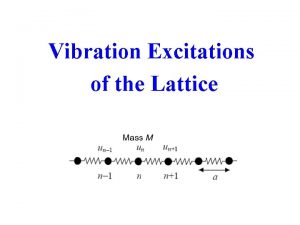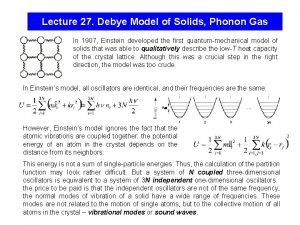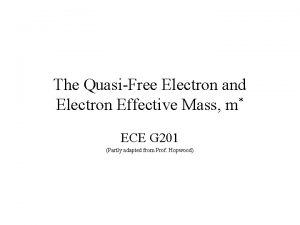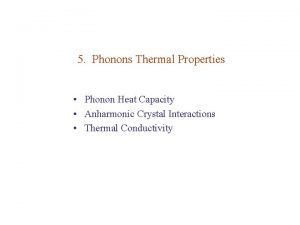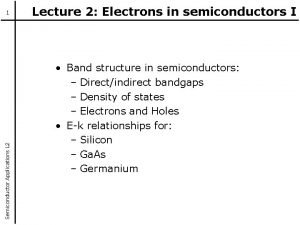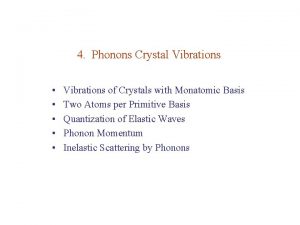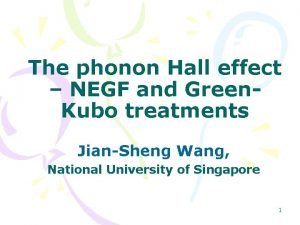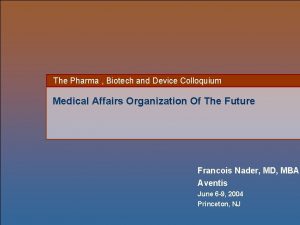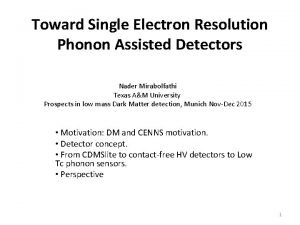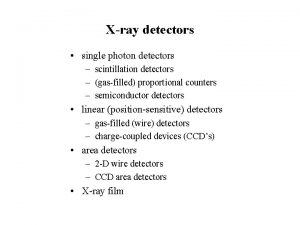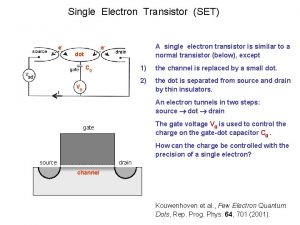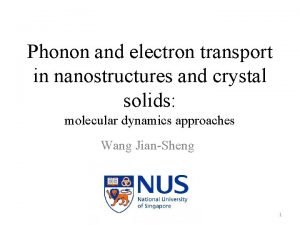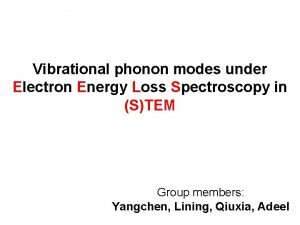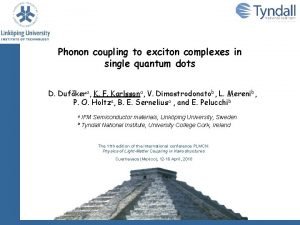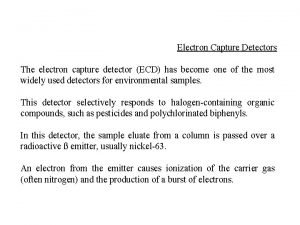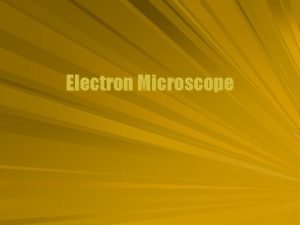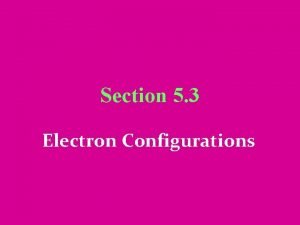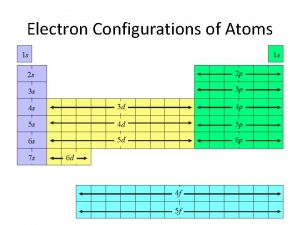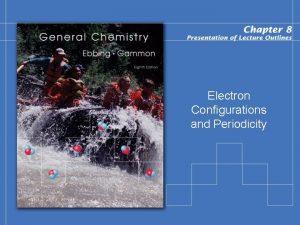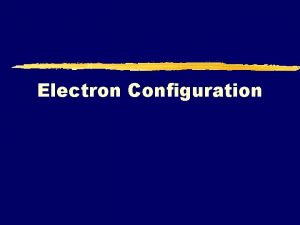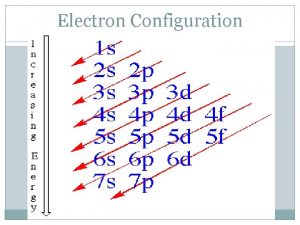Toward Single Electron Resolution Phonon Assisted Detectors Nader




























- Slides: 28

Toward Single Electron Resolution Phonon Assisted Detectors Nader Mirabolfathi Texas A&M University Prospects in low mass Dark Matter detection, Munich Nov-Dec 2015 • Motivation: DM and CENNS motivation. • Detector concept. • From CDMSlite to contact-free HV detectors to Low Tc phonon sensors. • Perspective 1

Two big question one solution Dark Matter Coherent Neutrino Nucleus Elastic Scattering: CENNS 2

Calorimetery with large absorber mass: A back of the envelope calculation! Germanium at 300 K CV=3200 J/kg·K and D=374 K CV at 0. 02 K = 5 e-10 J/kg·K =3 e 6 ke. V/kg·K 2 V 1 kg Ge T=0. 02 K Therefore for a 1 kg Ge absorber cooled down to 0. 02 K, T caused by a 10 ke. V deposit will be: ~3. 3 e-6 K A thermometer attached to the absorber with ~100: Signal I~ 40 n. A Noise~1 p. A/(Hz)^1/2 R ( ) Superconductor Transition Edge Sensor 1. 0 Typical for SQUID Amplifiers Very good resolution 0. 02 T (K) 4

d 4> d 3> d 2> d 1 d: Mean free path d 4 Anharmonic decay rate 5 Elastic scattering rate 4 d 1 d 2 d 3 5

CDMS Principle: Ionization & Athermal Phonon R T e- • Large Ge or Si crystals (~kg) cooled to: T < 0. 04 K • Measure recoil energy via Lattice vibrations (phonons) in Ge or Si • Measure the Ionization. E- field: ~3 V/cm • Ionizing power (Ionization yield: Y) • Near surface events • • h+ e- Electron recoil Yelectron-recoil> Ynuclear-recoil Event-by-event discrimination Electron recoil but poor charge collection Near geometrical boundaries Signal <20 micron <10 micron Charge deficit <5 micron Nuclear recoil 6

Luke-Neganov phonons • Phonon noise doesn’t scale with the ionization bias: => S/N • In theory one can increase Bias to reach Poisson fluctuation limit: limitation: Ge Breakdown Luke et al. , Nucl. Inst. Meth. Phys. Res. A 289, 406 (1990) 7

Low Noise Phonon readout • Phonons among the lowest quantum excitations in condense matter detectors. • Tremendous progress in low noise phonon readout down to fraction of e. V for small calorimeters. • Almost mass independent for athermal phonon measurement. • Various options to handle backgrounds: event-byevent discrimination. • Measure phonons directly or use Neganov-Luke effect to indirectly measure ionization down to e-h resolution. 8

CDMSlite: CDMS with phonon gain • Use the Luke phonon amplification to indirectly measure ionization using very good phonon resolution. • One i. ZIP (0. 625 kg) used for this data • ~70 kg. day exposure • Impressive 14 e. Vee resolution for Vbias=69 Volts. Limited to current leakage for V>70 Volts Or E> 24 Volts/cm Very low compared to standard 77 K Ge detectors 9

CDSMlite limitation: Breakdown? Data From R. B. Thakur Ph. D. Thesis 2015 10

Need to study breakdown! Injection through contact by tunneling • What causes the breakdown at such low fields? • Impact ionization on impurities: – Ionized – Neutral • Leakage through electrodes? • Conduction over detector free surface: – Better surface treatment? – Common problem if surface damaged. J. P. Mc. Kelvey, Solid-state and semiconductor physics, Harper & Row, 1966. S. M. Sze, Semiconductor devices: physics and technology, 2 nd Ed. , Wiley, 2002. Avalanche 11

P-type Point Contact Ge at @T< 0. 05 K • PPC are common design for 77 K Ge gamma spectrometers. • Experiments using ultra pure Ge PPC: Majorana, Co. Ge. NT, • LBNL provided a prototype Majorana PPC. • At UCB adhered a tungsten TES thermistor. 12

No Break down for V up to 400 Volts 13

E Field in PPC for Vbias=400 Volts 14

CDMS symmetric contact geometry • Use W TES (TC~75 m. K ) phonon sensors • Both faces of the detector uniformly covered with sensors. • Simultaneously measures athermal phonons and ionization. • Design tailored for excellent background rejection. Al W α-Si Ge In CDMSlite mode only readout one face phonon sensors. The other face used for biasing. 15

CDMSlite symmetric contact geometry Al W α-Si Ge 16

CDMSlite symmetric contact geometry Al W α-Si Ge Vacuum Al electrode 17

High Voltage athermal phonon readout: contact free biasing • One face of the detector processed similar to a CDMS II detector: • fully covered by Four W based athermal phonon readouts. • The other face of the detector left free • Bias the detector through a gap ~ 0. 5 mm Mirabolfathi et al. ar. Xiv: 1510. 00999 TAMU Berkeley 18

Contact free asymmetric results • The phonon sensor always at ground potential. • Observed a strong leakage polarity dependence. • Significant leakage when biased negative. => Holes leak through the interface • Requires further studies on contact properties. 19

Contact Free performance Mirabolfathi et al. ar. Xiv: 1510. 00999 20

Comparing Contact free and CDMSlite 1 cm Thick 2. 5 cm Thick Mirabolfathi et al. ar. Xiv: 1510. 00999 21

Baseline Resolution Given a fixed Ecritical 1 cm Thick 2. 5 cm Thick => × 2. 5 Vmax => × 2. 5 Phonon gain Mirabolfathi et al. ar. Xiv: 1510. 00999 Using this concept in CDMSlite i. ZIP absorber geometry, we expect to achieve: σ < 2. 8 e. Vee 22

Optimizing athermal phonon readout Matt Pyle (UCB)+Stonford and TAMU fab teams • Non flat noise very likely due to warm electronics. • Phonon signal and readout bandwidth mismatch. • Lowering Tc of the W sensors: Gain in S/N • W TC can be as low as 12 m. K depending on crystalline structure. • TAMU working on reproducible low TC sensors. Phonon energy Sensor impulse response 23

24

Conclusion • • Both low mass dark matter searches (e. g. CDMS) and coherent neutrino scattering experiments (e. g. MINERS) are striving for very low threshold detectors. CDMSlite already achieved unprecedented sensitivity for low mass WIMPs and is using the Neganov-Luke phonon amplification as detector principle. CDMSlite limitation of leakage current seems to originate form the particular electrode/absorber interface. Electrically insulating electrodes from the absorber can be a solution to reach very low threshold. For the very first step using vacuum as a perfect insulation, we achieved Luke amplification of × 50 and reached an RMS resolution of σ < 7 e. V in a 0. 25 kg Ge detector. Detectors with lower Tc phonon sensors should have dramatically better resolution. The advantage: Not limited by nuclear recoil ionization threshold. Active R&D to overcome sources of noise that limits the sensitivity is ongoing. We believe single electron resolution phonon mediated detectors are just couple devices away with exciting physics that they can deliver. 25

LUX/Z Su pe r. C DM S Dark Matter Direct Detection Current Status 26

Low Mass Threshold Limited 27

Super. CDMS: Many Experiments in One 28

Understanding Low Voltage Breakdown in CDMSlite • High purity gamma spectroscopy 77 K Ge detectors e. g. PPC at ~1000 V/cm • A Collaborative effort formed between 3 institutions • Proposal to UCOP INPAC-MRPI for R&D over 2 years in 2013 UC Berkeley Nader Mirabolfathi, Kyle Sundqvist, Bruno Serfass, Arran Phips and Dana Faiez. LBNL Kai Vetter, Paul Luke, Ryan Martin and Mark Amman TAMU Rupak Mahapatra, Rusty Harris, Mark Platt, Andrew Jastram and James Phillips. 29
 Phonon momentum
Phonon momentum Debye model of solids
Debye model of solids Fexedx
Fexedx Phonon heat capacity
Phonon heat capacity Phonon momentum
Phonon momentum Phonon momentum
Phonon momentum Phonon hall effect
Phonon hall effect Frontier detectors for frontier physics
Frontier detectors for frontier physics Photo detectors
Photo detectors Kinesthesis and vestibular sense
Kinesthesis and vestibular sense Gravitational wave hear murmurs universe
Gravitational wave hear murmurs universe Yodsawalai chodpathumwan
Yodsawalai chodpathumwan Nuclear detectors
Nuclear detectors Rhmd: evasion-resilient hardware malware detectors
Rhmd: evasion-resilient hardware malware detectors Photo detectors
Photo detectors Chromatography mobile phase and stationary phase
Chromatography mobile phase and stationary phase Feature detectors
Feature detectors Vhv voltage detectors
Vhv voltage detectors What is streaming potential
What is streaming potential Where are feature detectors located
Where are feature detectors located Giant wave detectors murmurs universe
Giant wave detectors murmurs universe High resolution low resolution
High resolution low resolution Nader alaridah
Nader alaridah Assis. prof.
Assis. prof. Francois nader
Francois nader Nader pin extrication
Nader pin extrication Nader ahmadi
Nader ahmadi Nader mirabolfathi
Nader mirabolfathi Enes bin mâlik zayed bin malek
Enes bin mâlik zayed bin malek
